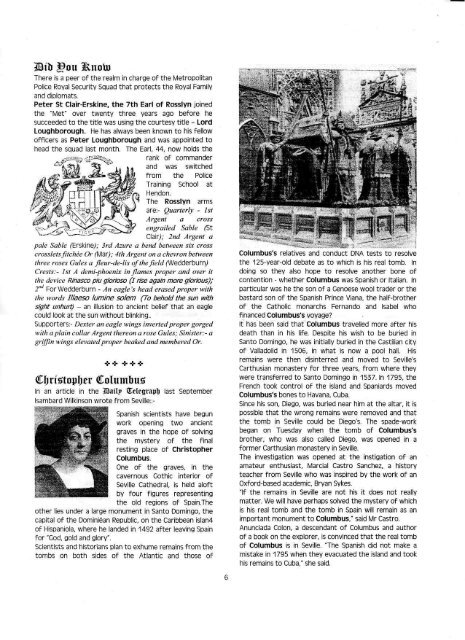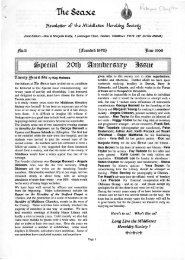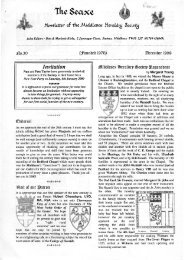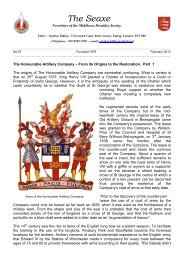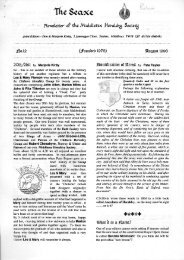The Seaxe - Middlesex Heraldry Society
The Seaxe - Middlesex Heraldry Society
The Seaxe - Middlesex Heraldry Society
Create successful ePaper yourself
Turn your PDF publications into a flip-book with our unique Google optimized e-Paper software.
Did You Know<br />
<strong>The</strong>re is a peer of the realm in charge of the Metropolitan<br />
Police Royal Security Squad that protects the Royal Family<br />
and diplomats.<br />
Peter St Clair-Erskine, the 7th Earl of Rosslyn joined<br />
the "Met" over twenty three years ago before he<br />
succeeded to the title was using the courtesy title - Lord<br />
Loughborough. He has always been known to his fellow<br />
officers as Peter Loughborough and was appointed to<br />
head the squad last month. <strong>The</strong> Earl, 44, now holds the<br />
rank of commander<br />
and was switched<br />
from the Police<br />
Training School at<br />
Hendon.<br />
<strong>The</strong> Rosslyn arms<br />
are:- Quarterly - 1st<br />
Argent a cross<br />
engrailed Sable (St<br />
Clair); 2nd Argent a<br />
pale Sable (Erskine); 3rd Azure a bend between six cross<br />
crosslets fitchée Or (Mar); 4th Argent on a chevron between<br />
three roses Gules a fleur-de-lis of the field (Wedderburn)<br />
Crests:- 1st A demi-phoenix in flames proper and over it<br />
the device Rinasco piu glorioso (I rise again more glorious);<br />
2nd For Wedderburn - An eagle's head erased proper with<br />
the words Illaeso lumine so/em (To behold the sun with<br />
sight unhurt) - an illusion to ancient belief that an eagle<br />
could look at the sun without blinking..<br />
Supporters:- Dexter an eagle wings inverted proper gorged<br />
with a plain collar Argent thereon a rose Gules; Sinister:- a<br />
griffin wings elevated proper beaked and membered Or.<br />
+ + + + +<br />
Christopher Columbus;<br />
In an article in the Daily Telegraph last September<br />
Isambard Wilkinson wrote from Seville::-<br />
Spanish scientists have begun<br />
work opening two ancient<br />
graves in the hope of solving<br />
the mystery of the final<br />
resting place of Christopher<br />
Columbus.<br />
One of the graves, in the<br />
cavernous Gothic interior of<br />
Seville Cathedral, is held aloft<br />
by four figures representing<br />
the old regions of Spain. <strong>The</strong><br />
other lies under a large monument in Santo Domingo, the<br />
capital of the Dominiean Republic, on the Caribbean islan4<br />
of Hispaniola, where he landed in 1492 after leaving Spain<br />
for "God, gold and glory".<br />
Scientists and historians plan to exhume remains from the<br />
tombs on both sides of the Atlantic and those of<br />
Columbus's relatives and conduct DNA tests to resolve<br />
the 125-year-old debate as to which is his real tomb. In<br />
doing so they also hope to resolve another bone of<br />
contention - whether Columbus was Spanish or Italian. In<br />
particular was he the son of a Genoese wool trader or the<br />
bastard son of the Spanish Prince Viana, the half-brother<br />
of the Catholic monarchs Fernando and Isabel who<br />
financed Columbus's voyage?<br />
It has been said that Columbus travelled more after his<br />
death than in his life. Despite his wish to be buried in<br />
Santo Domingo, he was initially buried in the Castilian city<br />
of Valladolid in 1506, in what is now a pool hall. His<br />
remains were then disinterred and moved to Seville's<br />
Carthusian monastery for three years, from where they<br />
were transferred to Santo Domingo in 1537. In 1795, the<br />
French took control of the island and Spaniards moved<br />
Columbus's bones to Havana, Cuba.<br />
Since his son, Diego, was buried near him at the altar, it is<br />
possible that the wrong remains were removed and that<br />
the tomb in Seville could be Diego's. <strong>The</strong> spade-work<br />
began on Tuesday when the tomb of Columbus's<br />
brother, who was also called Diego, was opened in a<br />
former Carthusian monastery in Seville.<br />
<strong>The</strong> investigation was opened at the instigation of an<br />
amateur enthusiast, Marcial Castro Sanchez, a history<br />
teacher from Seville who was inspired by the work of an<br />
Oxford-based academic, Bryan Sykes.<br />
"If the remains in Seville are not his it does not really<br />
matter. We will have perhaps solved the mystery of which<br />
is his real tomb and the tomb in Spain will remain as an<br />
important monument to Columbus," said Mr Castro.<br />
Anunciada Colon, a descendant of Columbus and author<br />
of a book on the explorer, is convinced that the real tomb<br />
of Columbus is in Seville. "<strong>The</strong> Spanish did not make a<br />
mistake in 1795 when they evacuated the island and took<br />
his remains to Cuba," she said.


